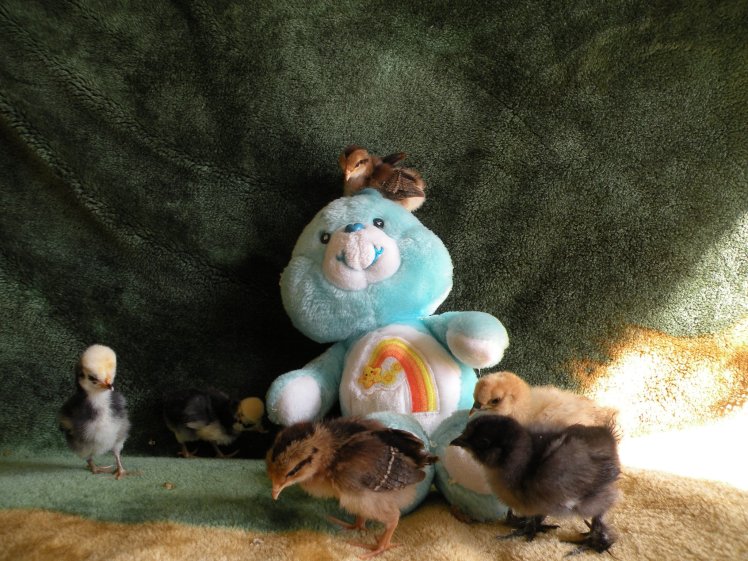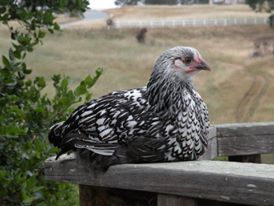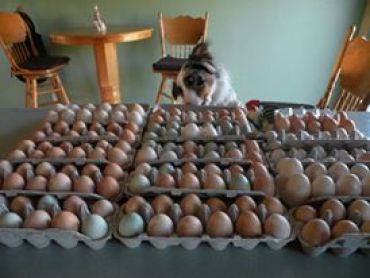Chicks! The word always brings a smile to my face. Just look at those adorable babies! It’s quite an experience caring for these tiny nuggets. But it’s also a big commitment. Perhaps you’ve been considering starting your own backyard flock? The idea may conjure up fantasies about rising out of bed at the crack of dawn, strolling out to your own pristine chicken coop and helping yourself to fresh eggs. The hens sleepily eye you with affection as you nudge them gently off their nests to gather the precious treasures lying underneath. Perfection. But why stop there? Maybe you could add some ducks to the mix. Dairy goats? Imagine milking your own cow ? You might even want to adopt a horse…whoa. Better take a deep breath. That’s better. Let’s just focus on the chickens for the moment. I promise to discuss all of those wonderful farm animals in the near future. Promise.
*Note: The following essay contains anecdotes from my own personal experiences and research concerning poultry care. There are many varying approaches and differing opinions regarding the subject. These are just a few ideas gathered from my adventures on the ranch. I highly recommend doing your own research as well.*
Do you dare take the plunge? There are so many questions that need answering. For example, is it best to start with adult chickens verses raising day old chicks? Both have their pros and cons, pluses, and minuses. It’s important to research your property’s zoning laws. Not all neighborhoods allow poultry. I’ve adopted quite a few hens from my local SPCA. Here I discovered a variety of birds, factory farmed chickens, aka battery hens, and even young chicks available for adoption. Many of my girls landed in the shelter after their owners realized chickens were illegal in their neighborhood. The other popular reason centers around the notion that chicks make excellent presents. Chickens are frequently surrendered to shelters after Easter. It turns out that the fuzzy darlings are a lot of work. Messy work. They are called fowl for a reason. Needless to say, gifting chicks for Easter is not always the wisest idea.
The other issue may seem somewhat obvious. Chicks grow up to be chickens. Your fuzzy babies will eventually grow up to be full-grown chickens or roosters. And yes, I said roosters. Did you know that there is at least a twenty percent chance of receiving male chicks, also known as cockerels, from your local feed store or poultry mail catalog? So, there are no guarantees. And those numbers are generous. Let me tell you. I’ve had a few of my girls hatch out eggs over the years. They averaged sixty percent males. Sometimes seventy. Be warned. Hens are smarter than you think. They are experts at hiding their

nests. You might end up with unexpected hatches. I’m forever grateful for my patient neighbors! We recently experienced a couple of unplanned broods on our property last Spring. The males outnumbered the females by two to one. Luckily our boys were born on a vegetarian farm!
How do you know if your chick is a boy? One day your little pullet, young hen, has developed a significant sized comb on top of its head. There’s a reddish growth underneath its beak. It’s called a wattle. Both are larger and darker in the males. Saddle feathers appear on its back, eventually spurs on its legs. Six months old and you hear its first, somewhat gravely, crow. It’s not so bad you tell yourself. But days turn into weeks and his voice matures. One morning you’re jarred out of bed by an ear piercing “Cock-a -doodle-doo!” Your dreams of fresh eggs have been shattered by the realization that your little lady is a cocky gentleman. Sigh… You might enjoy the sound of crowing in the early morning and/or random times throughout the day. I happen to appreciate the sound myself. Sometimes I imagine myself as a modern-day frontierswoman, a kind of Dr. Quinn Medicine Woman, forging my way out West, my trusty chickens by my side. But that’s just me.
Let’s not forget about our neighbors in these daydreams. It’s not a bad idea to discuss your poultry plans with the local residents ahead of time. That way they will not be surprised when they hear the unexpected cackling of a frantic laying hen… oh that’s just got to hurt. Or the high-pitch crows in the wee hours of the morning. Even during the day…all day. Perhaps you live in the country. Even better. Your neighbors are chicken enthusiasts! Great. You’ve done your research. FYI..they are probably secretly hoping you’ll share some fresh eggs. That’s not a bad idea by the way. Bribery has its rewards. So now you’re ready to jump in the deep end! But you still haven’t decided-chicks or chickens… or both.
Here are a few things to consider. Chicks need a lot of TLC . You will want to adjust your schedule accordingly. The little darlings need to be checked on at least five times a day. I can tell you it will probably turn out to be a lot more than that. There’s nothing like watching those fuzzy babies frolic and play! They must be kept inside at this stage, under a heat lamp, turned up to 95 degrees the first week. Ninety degrees the next. Plan to lower the temperature five degrees every week until they are ready to be transported outside into their outdoor coop. This usually occurs around 4-5 weeks.
I recommend a 250-what infrared heat lamp. A red bulb is easier on their eyes. It should be suspended over the brooder. Their enclosure should be at least twelve inches high. Allow two feet per bird or more. They grow surprisingly quickly and will eventually need the extra space. You can adjust the height of the lamp to achieve the appropriate temperature, preferably in the middle of the enclosure. You will notice if your chicks are too hot or too cold by observing their favored locations in the brooder. If they are huddled, sometimes piled on top of each other under the light, they are most likely too cold. Seeing them pressed up against the edges of the brooder, may indicate it’s too hot. It’s important to keep an eye on the temperature. A thermometer should be place inside the brooder. Check it frequently to insure proper temperature control.
Ask your local feed store for the appropriate equipment for raising chicks. They often have kits set up for beginners. This can be handy when you’re first starting out. The proper supplies will include a brooder, heat lamp with infrared bulb, shallow water and feed containers, thermometer, etc.
*Note: Be careful that your bedding is not flammable. Seriously. Heat lamps can pose a fire hazard if not set up correctly.*
In addition to your starter kit, you’ll need to purchase the appropriate bedding and food. The babies will require a chick starter feed, usually medicated, for the first several weeks.
*Always keep the medicated feed away from adult hens. You don’t want it passed to the eggs.*
The brooder’s bedding should consist of wood shavings or a similar natural product. Avoid cedar bedding products which can cause lung irritations. The chicks will soon be pecking and scratching their bedding daily. This can be a dusty affair. Be prepared. Some people choose to house their chicks in garages and workshops. I prefer to keep mine in my office.

It’s a little messy. I have to dust quite a bit when they’re inside. But I enjoy the extra time spent with them. Just make sure that their brooder is absent of drafts and safe from predators and house pets. Chicks are just a little too tempting for our furry companions. I can’t stress that enough.
*Note: See photo below. My cat, McCian, was quite taken with last year’s chicks. Luckily he’s a real sweetheart when it comes to our poultry pals. This is not always the case with all animals. It’s just nature. So keep them safe! Young children should also be monitored closely with young birds. It can be a wonderful learning experience for them. Little ones can be amazing helpers. Just make sure to teach them how to gently handle and care for their new chicks.*

At about five weeks old they are ready to make the transition outdoors. You will most likely be jumping for joy by this time. The chicks will be making quite a mess. It’s much easier to deal with them outside. They will need a secure chicken coop. The options and varieties are endless. Backyard flocks have become all the rage over the past several years. I’ve even seen chicken coops and organic feed being sold at Costco!
Your chickens should be allowed at least ten feet per bird if they are cooped inside full-time. Free ranging is always the best possible option. But you’ll want to consider the different kinds of predators in your area. Raccoons, skunks, opossums, coyotes, and hawks can all be lethal to your flock. Chickens will naturally roost in their coops at dusk. But it’s still important to secure their doors in the evenings. Your schedule will now revolve around your chickens. So plan accordingly.
Once the pullets, and or, cockerels are a few months old, their feed can be switched to an adult poultry mix, crumbles in the beginning, often followed by pellets depending on the breed size. Smaller bantams, and debeaked battery chickens, may prefer the easier digested crumbles.
And yes… I did say “debeaked”. It’s a common practice in many factory farms. The idea is to prevent the crowded birds from pecking each other in their cramped cages. I’ve adopted battery chickens from animals shelters in the past. Many of them had never seen the light of day. Their lifespans are often cut short by their circumstances. They are raised to lay eggs, usually for one to two years, loaded up with antibiotics, and then retired…aka being slaughtered. Some of the lucky ones end up in shelters. They are usually grateful for a second chance. So, in my humble opinion, debeaking is a very cruel practice. Very sad indeed. Alright…deep breath…I’m stepping off my soapbox for the moment.
Anyway, I prefer feeding my flock Purina Layena Pellets.
https://www.purinamills.com/chicken-feed/products/Layena/
It’s a natural vegetarian feed that is a great source of vitamins and minerals. It’s healthy for the birds and helps to ensure strong eggs. Chicken scratch can be given as a treat. However, it should never be their only source of nutrition. It lacks the vital nutrients important in egg laying and physical development. Free ranging chickens have the advantage of dining on fresh vegetation, weeds, insects and mollusks. Poultry can be very advantageous in the garden. Chicken manure is a wonderful source of fertilizer. Just watch those tomatoes grow! You will witness a definite decrease in snails, slugs and other annoying garden pests. Fresh vegetables and fruits can also be given as a treat. You’ve never seen such joy as a hen with a cherry tomato in its beak. Pure heaven!
So raising chicks to adulthood offers you the chance to bond with your birds from the start. Handle them daily to increase the bond. But you can still have the same connection when purchasing or adopting adult hens. Many shelters and rescue organizations have birds waiting for their forever homes. It’s always a wonderful feeling to give a hen or rooster a second chance. They’ll be grateful for it. Check out your local animal shelter or SPCA for more information.
There are some wonderful books on the subject of raising chickens. I’m only covering a few highlights from my own personal experiences and research. You may want to check out. “Storey’s Guide to Raising Chickens”. It’s a concise source of information on the subject. I just close my eyes when I pass the butchering chapters. If I haven’t mentioned it before…I’m a vegetarian. So all of my hens are raised as part of the family. No pots for my poultry. 🙂
Here’s an Amazon link for Storey’s Guide to Raising Chickens.
https://www.amazon.com/Storeys-Guide-Raising-Chickens-3rd/dp/1603424695
I want to wish you all the best in your poultry adventures. It’s a rewarding undertaking for those brave enough to try. I can’t imagine life without my girls…and boys. I’d love to hear back from anyone that takes the plunge. Chickens make the most amazing pets. You just might find yourself spending hours with your feathered companions. I know I do. So I hope you enjoy the ride. Good luck, readers!









Nice!
LikeLiked by 1 person
Thank you, Kyndra!
LikeLike